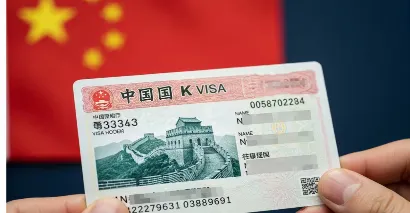Key Highlights
The much-awaited K employment visa in China, which is meant to ease the entry and movement of foreign professionals, has invited a torrent of criticism against it by the netizens and the local observers. The visa was announced with a lot of fanfare in August and was to be effective by October 1. This has not been implemented yet because the Chinese embassies in other countries are still closed till October 8 on national holidays. In the meantime, the social media backlash has increased--some have argued that the policy is premature, likely to be discriminatory to local graduates, and prone to abuse.
We will explore the specifics of the K visa, its critics, the bigger picture of the employment landscape in China, and how it will impact the foreign talent pool and the job seekers in China.
1. What Is the K Employment Visa?
Purpose and Goals
In the official statements, the K visa is aimed at promoting exchange and collaboration between China and foreign talents in science, technology, education, culture, and innovation.
China offers the K visa as similar to the U.S. H-1B: a special exception to host foreign professionals and offers greater convenience in terms of entry, visa term, and flexibility.
Key Features and Advantages
-
Higher Educational and Employment Requirements: The applicants should have a particular age, educational level (usually a degree in a STEM field or higher), and work experience requirements.
-
No Domestic Employer Sponsorship or Invitation: As opposed to most work visas, K visa applications do not require an existing employer in China to send an invitation.
-
More Preferred Visitors: A Visa would allow more entries, longer validity, and longer periods of stay than the current visa categories in China.
-
Post-Entry Flexibility: K visa holders are permitted to participate in exchange, business, or entrepreneurial, education, culture, and technology cooperation.
The K visa is, in effect, aimed at reducing the bureaucratic hurdles and bringing in talent across the globe without necessarily binding them to the domestic employer.
Also Read: How to Get China Visa from India? Fees, Visa, Steps & More
2. Why the Delay--and What Happens Next?
However, scheduled to enter into effect as of October 1, the introduction of the K visa was interrupted due to the fact that Chinese embassies abroad have been shut down until October 8, the National Day and Mid-Autumn Festival holidays.
Such stalling has contributed to confusion over the real launch date of the visa and prompted speculation to whether the policy is more symbolic than substantive at least in the short run.
3. Criticisms from Netizens
The criticism from netizens are:
(a) Poor Timing amid High Unemployment
The introduction of a visa to attract foreign professionals at a time when China is struggling with the issues of unemployment at home has been criticized by many netizens. Critics believe that there is already stiff competition among domestic job seekers, with unemployment rates reportedly high (some sources put it at about 19%), and 12 million graduates joining the labour force every year.
(b) Perceived Unfairness to Domestic Graduates
There have been suggestions that the policy of the K visa is a silent devaluation of Chinese degree holders, especially those from domestic institutions. The grievance revolves around the issue of whether it is right to consider foreign graduates with a bachelor's degree as the best talent and leave local graduates to find jobs or to undertake further studies.
In reaction, there are netizens who insist on the establishment of a master's degree level as a qualifying requirement for applicants of the K visa as a way of balancing the playing field.
(c) Risk of Fraud and Visa-Agency Exploitation
Since the policy will permit applications without an employer sponsor, some worry that a gray market of visa agents and intermediaries will be created. A single user warned that, unless it is thoroughly examined, foreign applicants may take advantage of loopholes or present forged qualifications.
(d) Questioning Whether STEM Bachelor’s Degree Is Enough
Others criticize the use of a bachelor's degree in STEM as a measure of the best talent. They complain that the standard is too low, particularly considering the standards of education in the country and the rising number of graduates in the STEM fields.
(e) Worries About Domestic Backlash or Policy Reversal
Considering the backlash, speculations are going on that the Chinese government might soften or change the visa regulations, introduce stricter measures, or postpone the major implementation. The level of criticism among the population implies that the authorities may reconsider the way the visa is interacting with the local job markets.
Also Read: China K Visa for STEM Talent vs $100K H-1B Fee Hike
4. China’s Employment Landscape: Context Matters
In order to figure out why the K visa is the subject of such hot air, we have to put it into context in the context of the overall Chinese employment reality.
Graduate Influx and Job Market Saturation
The number of Chinese students graduating every year is about 12 million. It is worth adding that the large number of newcomers into the labor force strains industries, particularly those within the tech, service, and education industries.
Slowing Economic Growth and Industrial Reshuffle
China’s economic growth has cooled relative to past decades. Structural shifts—from manufacturing to services, from export to domestic consumption—have introduced friction in the job market. Traditional sectors have shrunk, while new sectors demand multidimensional skills.
Unemployment Rate & Youth Joblessness
The economic growth of China has slowed compared to previous decades. The way of overworking has changed to one of producing services rather than manufacturing, and export to domestic consumption has introduced tension in the employment market. Old sectors have reduced, and new sectors require multidimensional skills.
Domestic Talent Retention & Brain Drain
Chinese leaders have focused on local creation and holding local talents. The policies tend to avoid brain drain and to have the domestic graduates appreciated first before resorting to foreign professionals.
Therefore, any visa policy that aims at foreigners should be struck in a way that does not appear to be sabotaging the internal needs.
5. Potential Benefits of the K Visa
In spite of the criticism, proponents believe the K visa would command some strategic benefits, both to China and to foreign professionals alike.
Key Strategy: To attract global innovation, the company is enhancing its products and services through the adoption of the latest technologies.
(a) Attracting Global Innovation
The visa can attract foreign researchers, entrepreneurs, and technologists by providing them with mobility and flexibility, who have the potential to add to the innovation service in China.
(b) Enhancing Cross-Border Collaboration
The openness of the visa to exchanges, cooperation, and entrepreneurship may increase joint ventures, technology transfers, culture, and international networks.
(c) Reducing Bureaucratic Hurdles
The K visa has the potential to streamline the process, reduce barriers of entry, and speed up the visa process by eliminating or lessening employer-sponsorship conditions.
(d) Signaling Openness
The K visa could be used as an indication in geopolitical times that China is open to foreign talent and working with others, despite the tension in the world.
6. Risks and Limitations to Watch
Such a large-scale implementation of a policy has risks.
-
Screening Problems: Checking of credentials, determining authenticity, and combating abuse may be a burden on bureaucracy.
-
Home Resentment: When it is seen as treating foreigners better than locals, the anger may increase, compelling policy reversal or adjustments.
-
Quality vs. Quantity Tradeoff: The absence of a robust set of criteria creates a risk of a flood of low-quality applicants that do not add value.
-
Regulatory Ambiguity: Unclear or vaguely defined standards can attract controversy, legal issues, or implementation inconsistencies.
-
Complexities of Integration: Once foreign professionals enter the country, they might face difficult situations with local regulatory, linguistic, cultural, or institutional barriers.
Also Read: Empowering Young STEM Minds: China’s New K Visa Launch
7. What to Watch in the Coming Months?
Implementation Timeline
Will China start issuing K visas after October 8, or not? Monitors will observe notices in the embassies and visa applications forums.
Revised Criteria or Amendments
With the pressure of the population, China could change the educational or experience requirements (such as a change from a bachelor's to a master's degree).
Domestic Feedback & Surveys
Tracking the voice of the Chinese graduates, industry theorists, and the institutions will reveal the viability of the visa on the political front.
Early Applicants and Use Cases
Who applies first? The appeal and initial success (or failure) of the policy will be disclosed by whether high-profile tech researchers, candidates of cultural exchange, or entrepreneurs will show the success (or failure).
Policy Spillover to Other Countries
This may be an action that other nations in Asia will consider emulating with an equal degree of openness or prudence regarding their work visa regimes.
Conclusion
The K employment visa in China is a radical step toward providing new avenues of international cooperation and inviting international talent without so much red tape. However, this policy has sparked many heated debates among the local populations as it is perceived to create more inequalities, preferring foreign graduates to the natives, and contributing to fraud. This is in an era when China has been struggling with a decelerating economy.
Contact TerraTern for more information.








